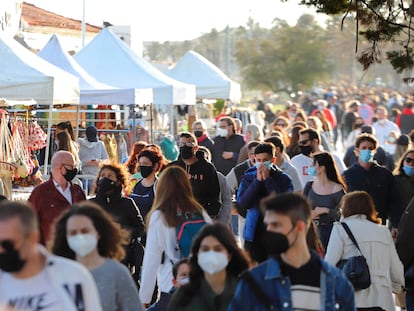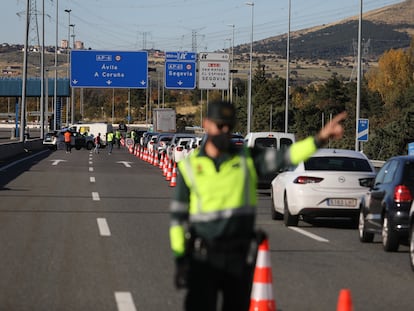Covid-19 occupancy rate in Spain’s ICUs now exceeds 20%
According to the latest report, the 14-day cumulative number of coronavirus cases per 100,000 inhabitants rose more than 25% in Navarre, Castilla y León and the North African exclave city of Ceuta

The percentage of intensive care unit (ICU) beds occupied by Covid-19 patients is the most worrying data point concerning the current situation of the pandemic in Spain. According to the Spanish Health Ministry’s latest epidemiological report, released Wednesday evening, the national occupancy rate now exceeds 20%, coming in at an average 20.09%. But in Catalonia, Madrid, La Rioja and the North African exclave city of Melilla, Covid-19 patients occupy more than 35% of all ICU beds. In the last 24 hours, 1,184 people have been admitted into intensive care with the virus, while 1,132 have left hospital – a figure that also includes deaths, although this is not detailed in the Health Ministry’s report. This is the highest ICU occupancy rate since March 16, when the third wave of the pandemic was still on a downward trend.
Spain is entering its fourth wave with ICUs already under great pressure. Since the third wave eased, the lowest this data point has fallen is 18.41%, a figure that was recorded on April 1. According to the latest report, a total of 2,009 Covid-19 patients are currently in intensive care.
As for the occupancy rate of regular hospital beds, this figure remains stable, falling slightly from 7.61% on Tuesday to 7.52% on Wednesday. Similar levels were reported in the second week of March.
The short-term outlook for the pandemic does not look good. The seven-day cumulative number of coronavirus cases has remained above 40,000 since March 18, coming in at 42,383 on Wednesday. Since the public holiday for Father’s Day or San José on March 19, the number of daily infections has not fallen below the average of 6,000. The total number of coronavirus cases in Spain now stands at 3,326,736. According to the latest report, the 14-day cumulative number of cases per 100,000 inhabitants also continues to rise. In one week, this data point has jumped from 152.25 to 167.97 on Wednesday.
The seven-day cumulative number of coronavirus cases has remained above 40,000 since March 18
But there are clear differences between Spain’s 17 regions and two North African exclave cities of Ceuta and Melilla. While the incidence rate has risen in 13 of the 19 territories in the past week, it has fallen in Asturias, the Balearic Islands, the Canary Islands, Catalonia, Galicia and Melilla. In the case of Catalonia and Melilla, however, although the incidence rate has dropped, it has done so from very high levels. Meanwhile, Navarre, Castilla y León and Ceuta have seen the sharpest rise, with the incidence rate increasing 25% in a week. It has also risen by more than 15% in Andalusia, Cantabria and the Basque Country. Valencia is the only region in Spain where the 14-day cumulative number of cases per 100,000 inhabitants is below 50.
The Health Ministry reported added 126 deaths to the official toll on Wednesday, a similar figure to Tuesday’s figure of 128. The total death toll now stands at 76,037. With respect to the seven-day cumulative number of fatalities, this data point has been around 600 since Monday. This represents a fall from last week, when it stood at 1,200, but it is not yet known whether the increase in serious cases, as reflected by the rising occupancy rate in ICUs, will have an impact on the number of Covid-19 deaths.
To prevent a repeat of the situation seen in previous waves, the Spanish Federation of Medical Scientists (Facme) has called on all levels of government to “stop the discrepancies and disagreements when the time comes for decisions” and for “clear, common and rigorous” protocols for health workers. Facme also asked the public to “protect themselves and to protect the rest of the population.”
English version by Melissa Kitson.
Tu suscripción se está usando en otro dispositivo
¿Quieres añadir otro usuario a tu suscripción?
Si continúas leyendo en este dispositivo, no se podrá leer en el otro.
FlechaTu suscripción se está usando en otro dispositivo y solo puedes acceder a EL PAÍS desde un dispositivo a la vez.
Si quieres compartir tu cuenta, cambia tu suscripción a la modalidad Premium, así podrás añadir otro usuario. Cada uno accederá con su propia cuenta de email, lo que os permitirá personalizar vuestra experiencia en EL PAÍS.
¿Tienes una suscripción de empresa? Accede aquí para contratar más cuentas.
En el caso de no saber quién está usando tu cuenta, te recomendamos cambiar tu contraseña aquí.
Si decides continuar compartiendo tu cuenta, este mensaje se mostrará en tu dispositivo y en el de la otra persona que está usando tu cuenta de forma indefinida, afectando a tu experiencia de lectura. Puedes consultar aquí los términos y condiciones de la suscripción digital.
More information
Últimas noticias
The complicated life of Francesca Albanese: A rising figure in Italy but barred from every bank by Trump’s sanctions
How Japan is trying to avert ‘digital defeat’
Half of Scotland is in the hands of 420 property owners
Reinhard Genzel, Nobel laureate in physics: ‘One-minute videos will never give you the truth’
Most viewed
- Pablo Escobar’s hippos: A serious environmental problem, 40 years on
- Why we lost the habit of sleeping in two segments and how that changed our sense of time
- Charles Dubouloz, mountaineering star, retires at 36 with a farewell tour inspired by Walter Bonatti
- Reinhard Genzel, Nobel laureate in physics: ‘One-minute videos will never give you the truth’
- The Florida Keys tourist paradise is besieged by immigration agents: ‘We’ve never seen anything like this’










































